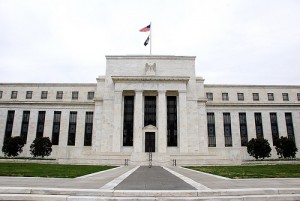Posted on 12 January 2011. Tags: application activity, business contacts, commodity prices, employment levels, labor department, monetary policy, mortgage application, mortgage bankers association, price pressures, u s home
 The stunted labor market in the United States may be heading up, according to a report coming from the Federal Reserve that found moderately better job conditions throughout the country.
The stunted labor market in the United States may be heading up, according to a report coming from the Federal Reserve that found moderately better job conditions throughout the country.
The Fed’s Beige Book was based on the anecdotal reports that the central bank has gathered from its business contacts in the regional branches and showed an increasingly bright, yet guarded picture.
The results matched with the recent increase in the U.S economic data that impelled some economists to raise their growth forecasts in the first half of this year.
The Fed said that all district reports indicated that employment levels are increasing in at least some areas, usually by moderate amounts. Manufacturing also emerged to be doing well. However, many businesses are still in a wary while U.S housing sector is still left in a rut.
Meanwhile, the latest data showed modestly better outlook on U.S home mortgages as lending rates were relieved from recent highs. The seasonally adjusted index of mortgage application activity rose 2.2 percent last week, according to the Mortgage Bankers Association. The figures went up its highest level in just one month.
The report by Fed also forecasted an increase in price pressures for businesses. However, there is little evidence that this will be passed on to consumers. The findings reflected the data on import prices that jumped 1.1 percent in December after a revised 1.5 percent increase in November.
According to the Labor Department, prices were up 4.8 percent last year. A low inflation environment in the country has permitted the Federal Reserve to maintain a very loose monetary policy. However, the recent increase in global energy and commodity prices has lifted some concern regarding cost pressures.
Posted in Business
Posted on 30 September 2010. Tags: consumption, dollar weakness, economy, emerging economies, global currency, guido mantega, long term unemployment, low interest rates, monetary policy, second wave
 Joseph Stiglitz, a Nobel Prize winning economist, said that large emerging economies can still live with weak dollar rate as his defense for the need of new round of U.S economic stimulus on Thursday.
Joseph Stiglitz, a Nobel Prize winning economist, said that large emerging economies can still live with weak dollar rate as his defense for the need of new round of U.S economic stimulus on Thursday.
According to Stiglitz, US monetary policy seems to be working its way through “competitive currency devaluation.” This is caused by the recent weakening of the dollar rate that makes the value of U.S exports cheaper.
Additional U.S monetary easing will most probably cause another dollar weakness. This might cause a threat to emerging countries’ exporters.
These large, emerging countries include Brazil, China and India. As mentioned by Stigilitz, these three countries are still competitive enough to withstand the present dollar rate. However, there annoyance and concern about it is really understandable.
Brazilian Finance Minister Guido Mantega said earlier this week that “global currency war” has already started and several concerns about the currency devaluation are spreading fast among emerging economies.
The reason why U.S monetary stimulus was not able to spur lending since companies are also not investing given the fact that there is less consumer demand.
He says that an excellent solution to solve this problem is to create a second wave of stimulus intended to encourage investment instead of more consumption. The U.S government is not wise not to borrow at the current low interest rates in order to enhance the economy.
Indeed, Stiglitz is not very optimistic with regards to the U.S economy’s future. He says, numbers are pretty depressing and the increased percentage of long-term unemployment remains the real problem.
Posted in Finance
 The stunted labor market in the United States may be heading up, according to a report coming from the Federal Reserve that found moderately better job conditions throughout the country.
The stunted labor market in the United States may be heading up, according to a report coming from the Federal Reserve that found moderately better job conditions throughout the country.

